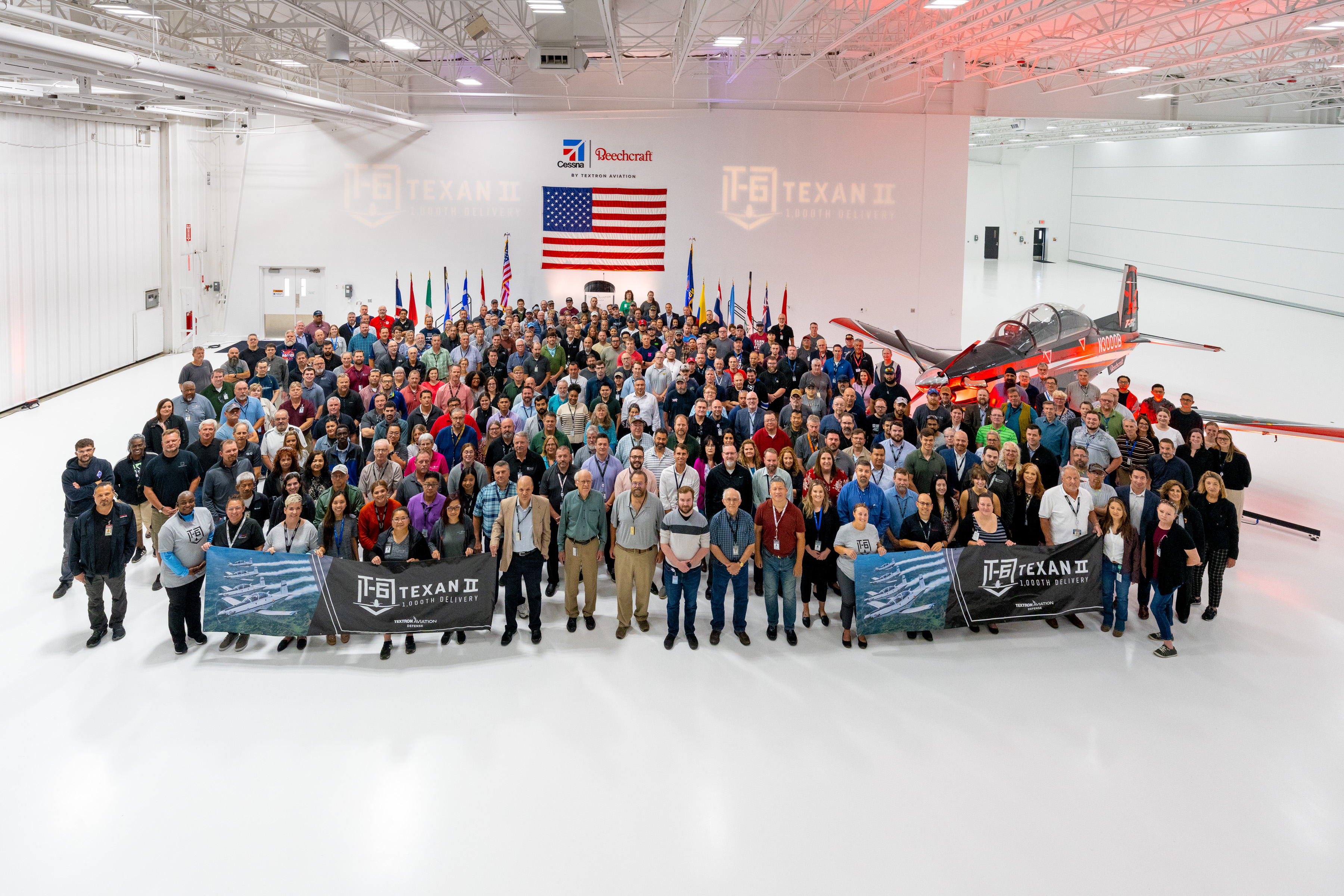For the last sixty years, the Colombian Air Force (FAC) had presented itself as a successful user of the Cessna T-37 Tweets, in its various variants, always operating in the Combat Air Command 1 ( CACOM) , at the Base Aerial of Palanquero, located northeast of the capital Bogotá. After approximately 53 years of service, the Tweets saw their retirement, due to the arrival of the Beechcraft T-6C Texan II, which has landed to join a second operator in South America, a new story is being created!
Latest Tweets from America
The FAC’s path to renewal in its fixed-wing training and combat assets is undoubtedly taking shape, because of which it has been seen as the Vietnam-era Cessna A-37 Dragonfly and its sibling training twin, the T-37 Tweets, have recently been decommissioned from active service from CACOM 3, on March 31, 2020, and from CACOM 1 at Palanquero, in June 2021, respectively.
This is how the first fifteen lightly armed Tweet T-37C ( FAC-2100 to FAC-2114 ), were acquired by the FAC to fly from the Palanquero air base, in 1968, replacing the Lockheed T-33 Shooting Star, while the last delivery of surplus T-37Bs to the United States Air Force (USAF), began in 2010. Around 38 Tweets served the Colombian Air Force, becoming the last operational aircraft of this class in the Americas.

During an official retirement ceremony at Palanquero Air Base ( PQE ) on June 10, 2021, the last two Tweets featured a flight formation with two of the new Beechcraft T-6C Texan II single-engine aircraft, announcing their withdrawal from operational service. FAC, after 53 years of service, where he trained nearly 1,500 pilots, according to Group Commander Colonel Alexander “Lex” Arbolera Medina. The same Lieutenant Colonel, who flew the Tweet, noted that the small twin-engine plane became difficult to maintain, as it could take two to three months for its parts to be delivered.
This is how the challenges in training for the T-37 Pilot School became increasingly difficult to overcome, which ultimately led to the start of negotiations with the American company Textron, in 2018.
Currently, the remaining discharged Tweets from the 116th Fighter Squadron “ Tango ” have been sidelined to the outside hangars and air base maintenance quarters, waiting to spend the rest of their lives on an honorary flagpole, or in a museum. In this way, the Pakistan Air Force is now the only remaining military operator of the old Tweet in the world.
Propellers instead of jets
Prior to selecting the Beechcraft T-6C Texan II, several options existed to replace the T-37. Along these same lines, the Colombians created the ” Aircraft Selection for Basic and Primary Training Using the Fuzzy AHP Model (Fuzzy Analytic Hierarchy Process) for the Colombian Air Force “, a project that included a new C-172 factory for basic training.
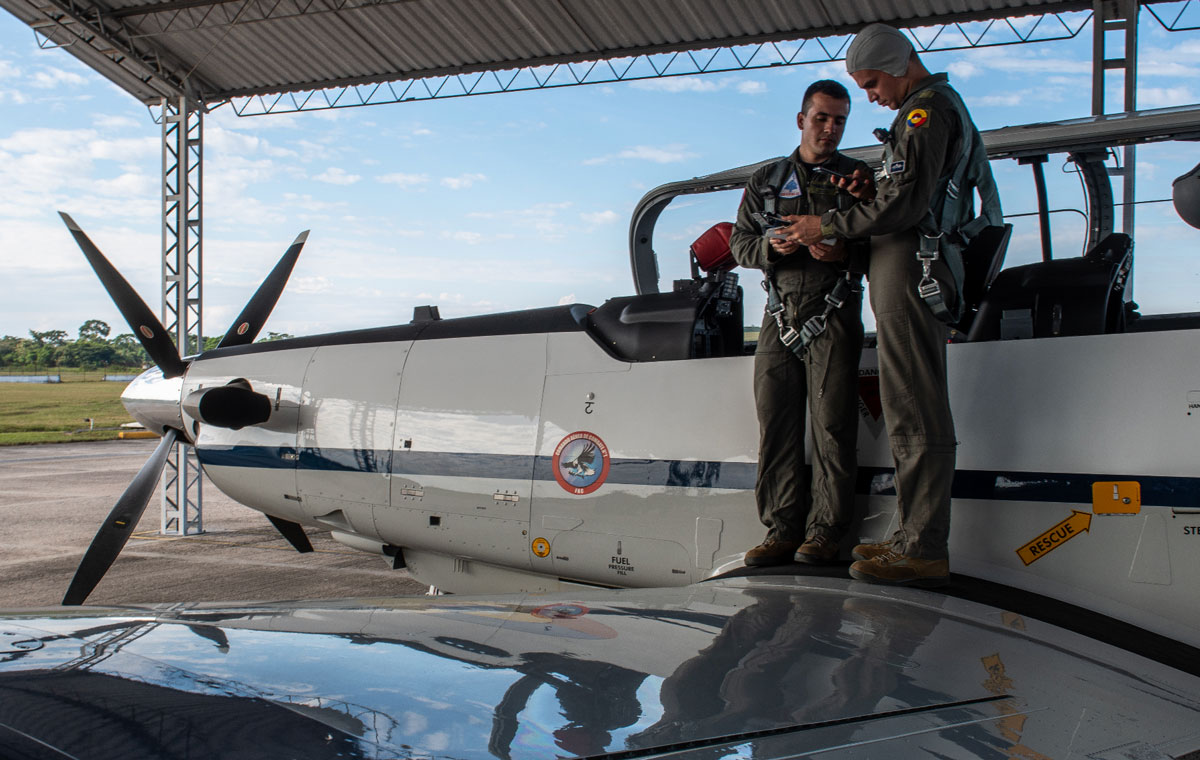
According to internal FAC sources, the Brazilian Embraer A-29 Super Tucano; the Swiss Pilatus PC-9 and PC-21, the Korean KAI KT-1 and the Czech L-39NG, are the only aircraft that were evaluated by the FAC. Finally, in a small list, were the Pilatus PC-21 and the Texan II. Focusing on the future, the requirements for the Colombian Air Force not only replace the aging T-37 in its training role, but also some aspects suggested a modernization project similar to that of the Embraer A/T-27 Tucano, which currently, have been removed from their light offensive role, they gave the Texan II more chances. Unfortunately for the Pilatus aerospace company, the PC-21 lacked offensive capabilities that could become crucial to Colombia’s internal conflict with the various guerrilla factions.

The acquisition cost, the life cycle cost, the spread times, as well as the strategic relationships were taken into account in the selection, which in June 2020, led the T-6C to become the winner of the project, the Beechcraft T-6C Texan II being chosen. It is understood that the acquisition process within the General Command of the FAC was slightly complicated and that obtaining a replacement Tweet was quite a challenge, in fact, the funds in the Colombian Air Force were displaced and all the units of the FAC they had to slightly reduce spending in pursuit of the acquisition of the turboprop trainer.
This is how the Texan II has an open architecture, with three multifunctional liquid crystal displays, a flight control system with throttle and stick ( HOTAS ), two Martin-Baker MkUS16LA 0/0 ejection seats and an Initial Integrated Control ( UFCP). In addition, it has Advanced Esterline CMC Cockpit 4000 avionics, with double FAA-certified flight management system (FMS), GPS/INS navigation systems, Heads-up display (HUD) and digital video recorder, among other systems. last generation. In terms of performance, the Texan II is powered by a Pratt & Whitney PT6A-68 engine, rated at 1,100 hp, allowing it to fly at a cruising altitude of 31,000 feet (9.45 km) and reach a speed of 316 knots (585 km/h), with a range of 883 nautical miles (1,637 km).
Currently, the installation of electromagnetic masts at six strong points (three per side) at the base of the wing allows operators to carry external stores. The standard 14-inch NATO configuration is not built in, although all other provisions are installed and ready to go.
Knowing the new assets of Colombia
Before the first Texan was delivered to the Colombian Air Force, five young men, including lieutenants and captains, came from different operating environments, along with five ground technicians, to receive training at the Beechcraft facility in Wichita, Kansas. The pilots had two months of training, of which two weeks were ground school. Sixteen training flights per student were carried out, in which general, low-level, instrumentation and aerobatic instruction flights were carried out.
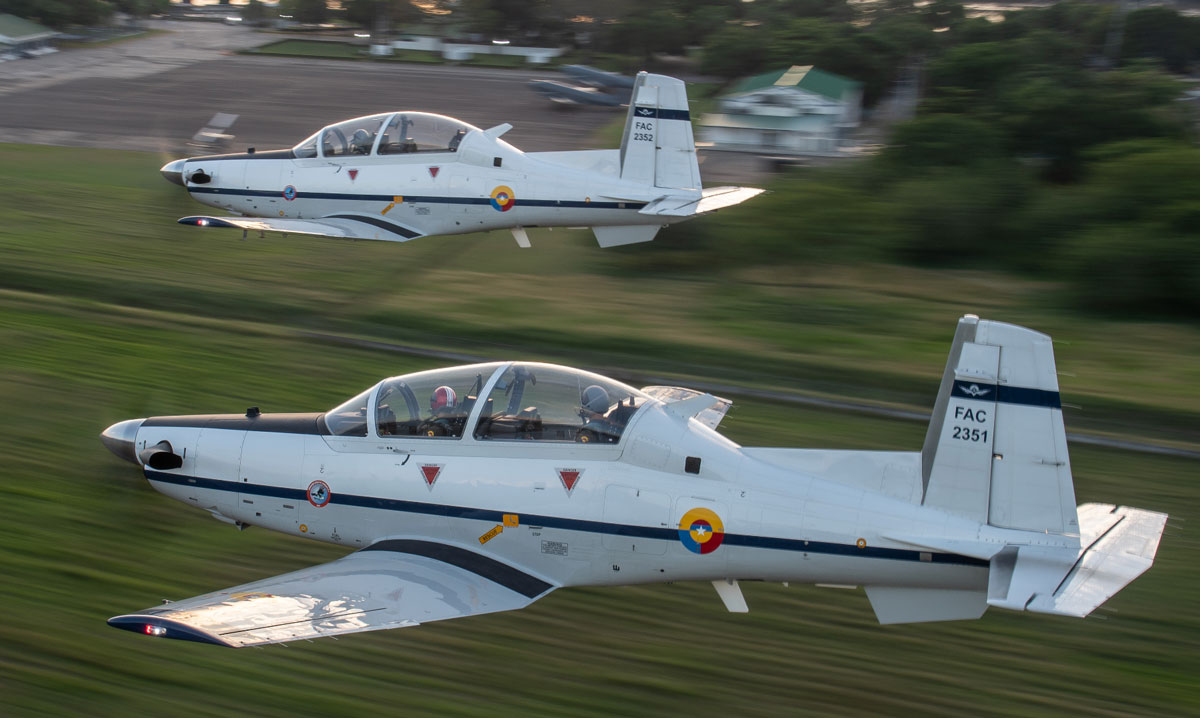
Textron Aviation Chief Pilot and Delivery Demonstration Instructor, Jonatan Wrinn, has been pleasantly surprised by his Colombian students, in fact commenting on their progress: “In effect, we decided to accelerate the program and instead of waiting until the ten flights to go in close formation, with the Colombian students we did it on the third and fourth flight” adding that “the capabilities of the Colombian pilots led us to be able to land in close formations that we did not know”. The USAF veteran also commented that “a lot of that helped, as these planes are very, very easy to keep together in formation, plus the plane has a great power-to-weight ratio and the power response in the T- 6 is faster than in a jet. When full throttle.
The T-6C delivery ceremony, in April 2021l, was attended by: Tom Hammoor, President and CEO of Textron Aviation Defense, Major General Pablo Enrique García Valencia, Deputy Commander and Chief of the Air Force Team Air Force, Major General Henry Quintero Barrios and many others.
On May 4, 2021, T-6Cs FAC-2350 ( N2878B) and FAC-2351 ( N2804B) left the Beechcraft facility in Wichita, beginning a five-day trip south, making several stops in Central America. On May 8, FAC2350 landed confidentially in Bogotá, the capital of Colombia, while FAC2351 experienced a delay, finally landing in the country on May 13. The Commander of the Colombian Air Force, General Ramsés Rueda, highlighted the arrival of the T-6 as “an aircraft with the highest standards, with which new pilots can be trained, today and in the future, to be part of the squadron.” and defend our national sovereignty” and then continued: “Colombians know that their Air Force pursues NATO standards, and now that we are their global partners, we aim for interoperability.” For his part, the Commander of PQE,
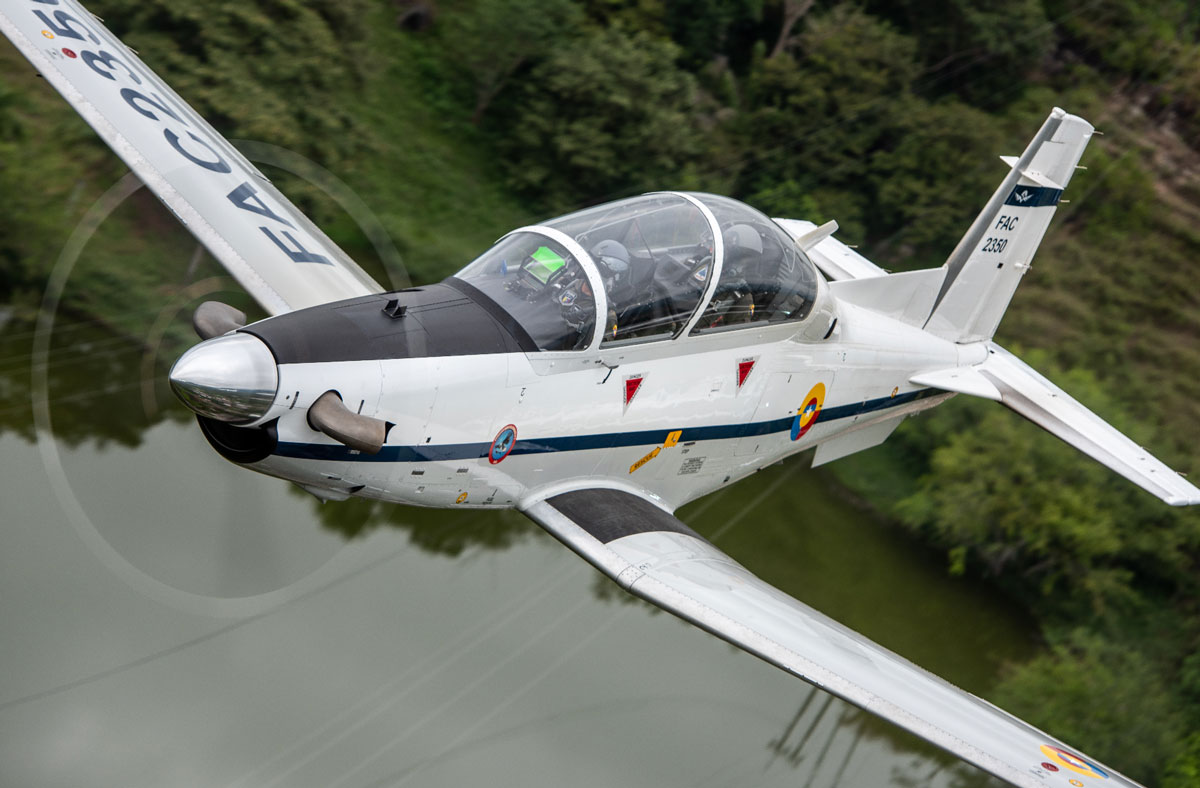
With the introduction of the T-6C to the squadron, the name changed to: T-6C “Texan” Basic Flight Training Squadron.
Colombian media reported that the contract for the acquisition of the first three T-6s, signed with the US company, is valued at $109,190,028,324 million Colombian pesos, equivalent to approximately 28.7 million dollars. This includes spare parts, ground equipment, pilot training, maintenance equipment, etc. There is quite a bit of speculation about the exact number of aircraft on order. General Martínez expects to receive between two to four more aircraft in 2022, making a total of 12 Texans, which will be assigned to the 116 Squadron. General Rueda pointed out in his speech during the reception of the aircraft that the FAC requirement for the T-6C is currently set at 24 aircraft.
A new aerial demonstration team is being created
The Commander of the new brand of Squadron T-6, Captain Cristian Andrés “Warrior” Guerrero, feels that it is a true honor to lead this new step for the FAC. “This requires a lot of responsibility, which is not always easy, but I see this as one of the best things that has happened to me in my life”, and he continues, “the plane has great capabilities, which will allow pilots to multiply his skills. Some young lieutenants who arrive have only 40 hours of basic flight training. In my Squad, they will fly around 150 hours in aerobatic flight, close formation, and air-to-air and air-to-ground missions, giving them the ability to become fighter pilots.”
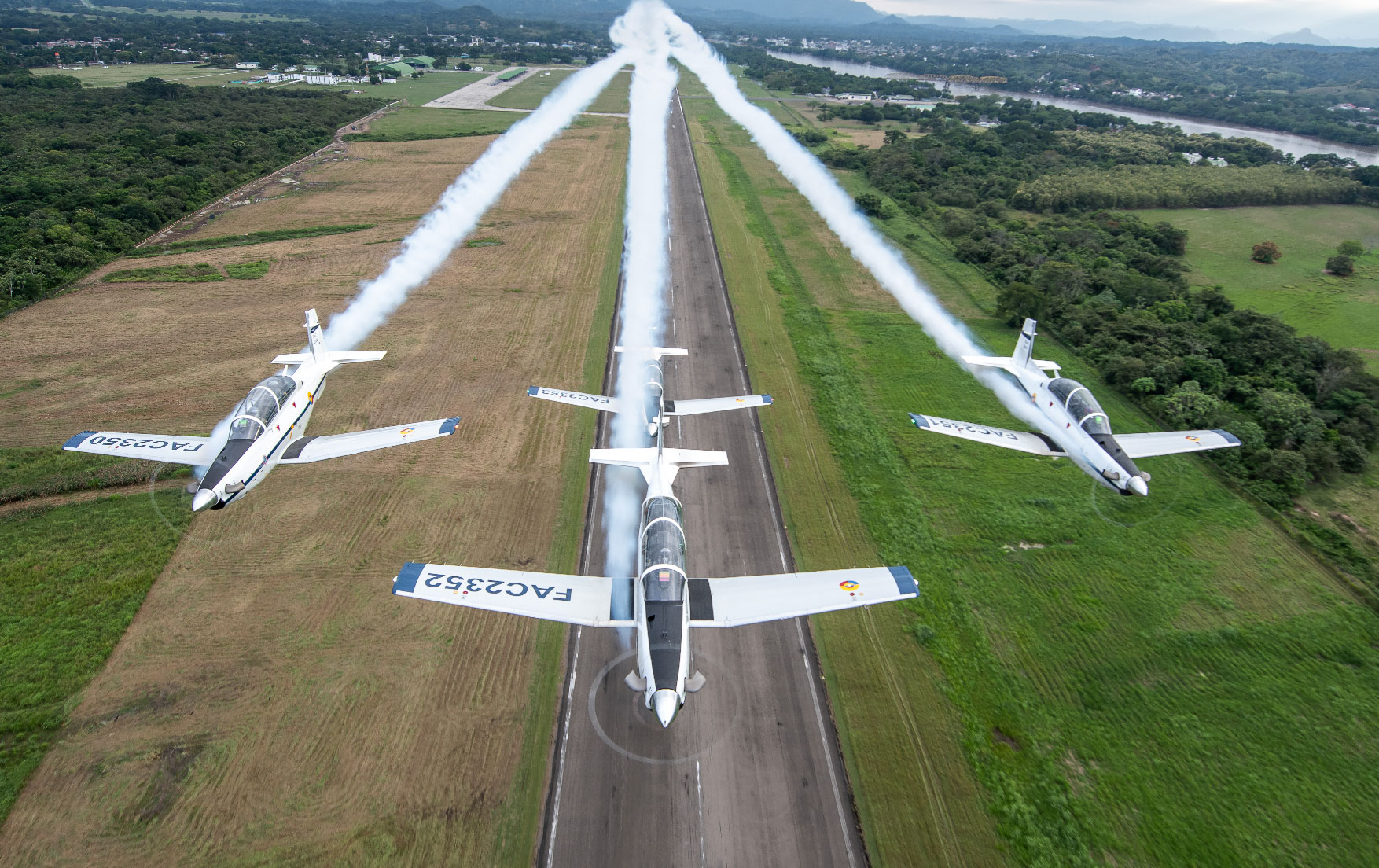
The Warrior Captain also oversees the newly established aerobatic team, where the first steps are being taken with four Texans equipped with smoke generators. The goal is to integrate six aircraft for displays and two T-6s as spares into the team. For his part, Lieutenant Colonel Arbolera proudly announced that Izeth “Linx” Fiandiño, a young female Captain, became the first director of the new team, in fact she was the first female pilot in the FAC’s A-29 Super Tucano. in 2013, while in 2015 she became the leader of a combat mission.
In 2021, La Capitan was selected to be a pilot instructor for the new Texans brand. She will have a challenging task ahead of her, leading her team as proud ambassadors of the Colombian Air Force around America.
The Group Commander pointed out that the FAC is observing aerobatic, commercial and military teams or schools in America and the United Kingdom, although in the appointment process, no concrete decisions have yet been made.
In addition to the new team, Lieutenant Colonel Arbolera is also running the school, which is still established in Palanquero, but is planned to move to Cali. The project under the name “Skyhawk”, has four new Ce-172 and will operate under the same coordinator as the Texan team. However, it is now planned that the Cessnas will be based on a concrete runway at Velasquez, 1,600 meters, about 15 minutes southeast of PQE. The latter is considered too busy for the 20-24 Ce-172, which are planned to operate in primary pilot training. The school will be called: “ESIAF”: International Fixed Wing School for primary (basic) and advanced training, obviously aimed at the Latin American military market.
Until last year, the training of Air Force pilots in Colombia was concentrated around the Tweet: T-90 Calima, T-41 Mescalero, T-27 Tucano and T-37. The standardization with the Texan C-172 and T-6C means a big step forward for the Colombian Air Force.
PQE Commander Brigadier General Martínez
The General was promoted to his current position at CACOM 1 in November 2020, in Palanquero, with a background as a former combat and transport pilot with nearly 6,300 hours in his log where he lists Tweet, Bronco, Do-328, Super Tucano and Fokker F-28. Responsibility for it is distributed over the airspace of seven states, with about 6.7 million inhabitants. His airbase is home to some military aviation legends such as the Douglas/Basler AC-47T Phantom and IAI Kfir COA, as well as new Texans, Cessna 208 Grand Caravan, Casa Cn-235EW and a single IAI Arava.
The Commander of CACOM 1 commented “he dreams of having an aerobatic team and we are working hard to achieve that goal”. According to the General, the Kfir only has two years left as the main combat bomber in the Colombian Air Force, since spare parts are not easy to get, because they are very expensive, in fact, it is estimated that for only an hour of flight, the cost is approximately 7,000 dollars.
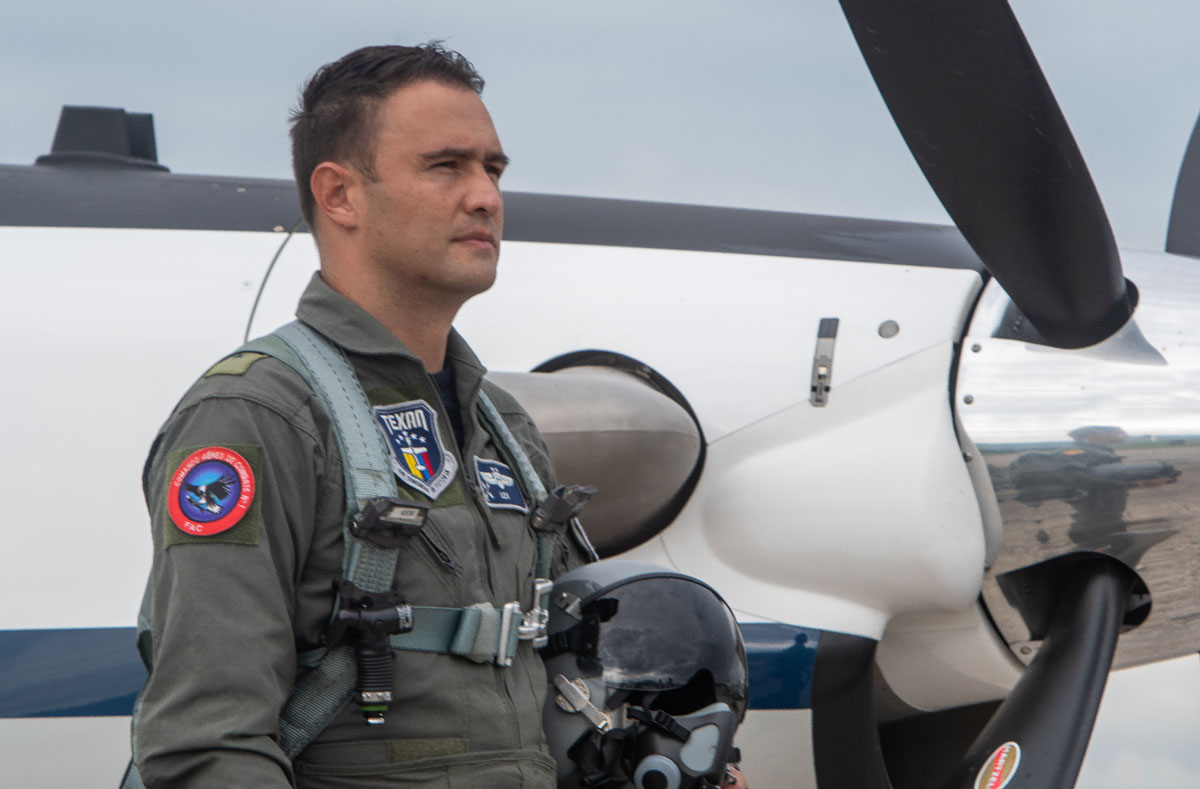
“Colombians must understand that this project is to defend the nation and that the investment in a new combat aircraft is for the security of our country.” General Martínez added that after 2023, it will be a challenge to guarantee air defense.
Recent reports, as well as a FAC source, suggest that the government has received bids for F-16AM/BMs from the Royal Danish Air Force (RDAF) through the Foreign Military Sales (FMS) program in conjunction with the United States. These fighters are seen as an intermediate solution for the new F-16Vs, which could be available by 2025. However, there is still no concrete information on any firm contact between Lockheed Martin and Colombia. The General diplomatically points out that the project is still under review, but that there are three candidates (Viper, Gripen and Typhoon) that are being studied. “This is a political decision”, concludes the General.
In this way the pilots of the Colombian Air Force will be prepared for any new replacement of Kfrir that is necessary, regardless of the result in the new selection of combat aircraft of the FAC and its new passage next to the Beechcraft T-6C Texan II.
Article taken from: https://vortexxmag.com/el-aterrizaje-de-los-texan-ii-en-colombia-2/
Images taken from: https://vortexxmag.com/el-aterrizaje-de-los-texan-ii-en-colombia-2/


